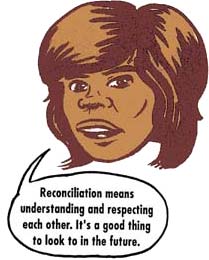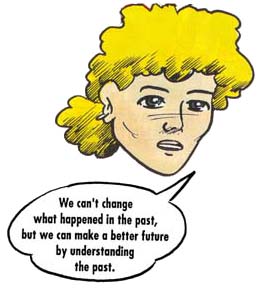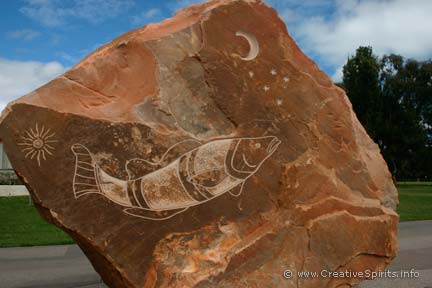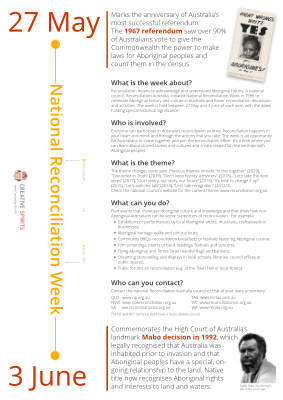People
What you need to know about reconciliation
More and more Australians want to learn about reconciliation with Aboriginal people: What's the meaning of reconciliation? How can you contribute? And what is a RAP? Here are your answers.

Wishing you knew more about Aboriginal culture? Search no more.
Get key foundational knowledge about Aboriginal culture in a fun and engaging way.
This is no ordinary resource: It includes a fictional story, quizzes, crosswords and even a treasure hunt.
Stop feeling bad about not knowing. Make it fun to know better.
Selected statistics
-
73% - Percentage of Aboriginal people who want to do something more to support reconciliation. [1]
-
54% - Percentage for non-Aboriginal Australians. [1]
- 2000
- Year in which 250,000 people walked across the Sydney Harbour Bridge to support reconciliation.
Definition: What is reconciliation?

In its broadest sense ‘reconciliation’ means 'coming together'. The dictionary defines ‘reconciliation’ as a situation in which two people, or groups of people, become friendly again after they have argued.
In Australia, 'reconciliation' refers to bringing together Aboriginal people and non-Aboriginal Australians.
Reconciliation is not something that one decides to ‘do’ – it is a process, at the end of which there may be reconciliation, but this can never be guaranteed.
Reconciliation has elements of truth, justice, forgiveness, healing, reparation, and love.
Supporting reconciliation means working to overcome the division (often called "the gap") and inequality between Aboriginal and non-Aboriginal people.
Differences are biggest in health, income, living standards and life expectancy, but also prejudice and racism.
Australia's reconciliation process is unique in the world. Almost all reconciliation processes are based on truth and justice, but Australia's is not. The truth-telling, called for by the Uluru Statement From the Heart, is still due. Australia's reconciliation process "obscures" the roles of politics and the economy, a study found, and strongly influences Australians' perception of Aboriginal people. [2]
Download the infographic about National Reconciliation Week to understand the two historic events that frame a week full of activities, and what you can do to help reconciliation.
The river is the river and the sea is the sea. Salt water and fresh, two separate domains. Each has its own complex patterns, origins, stories. Even though they come together they will always exist in their own right. Our hope for Reconciliation is like that.
— Patrick Dodson [3]
How did reconciliation start in Australia?
The process of Reconciliation formally began as a result of the Report of the Royal Commission into Aboriginal Deaths in Custody in 1991.
The government formed the Council for Aboriginal Reconciliation, setting a 10 year timeframe to advance a national process of reconciliation.
Among the Council's tasks was to address Aboriginal disadvantage and aspirations in employment, health infrastructure and economic development.
It identified 8 key issues in the reconciliation process:
- Understanding country
- Improving relationships
- Valuing cultures
- Sharing history
- Addressing disadvantage
- Custody levels
- Destiny (Aboriginal people controlling their own destiny)
- Formal documentation of the process
The Council's formation was an acknowledgment of the past and ongoing failure of government policy to recognise and address the cultural, social and economic needs of Aboriginal Australians. It was also recognition that progress also required a sea change in the understanding and involvement of non-Aboriginal Australians.
While the reconciliation process has successfully motivated and moved thousands of ordinary people, court decisions, laws and political developments made the reconciliation process much harder.
The Australian Capital Territory became the first state or territory to recognise reconciliation with a public holiday when it changed its Family & Community Day to become a Reconciliation Day public holiday in 2018. It will now be the first Monday on or after 27 May.
Story: Reconciliation rocks!
It is the middle of winter 1770, and Captain James Cook anchors his ship in a bay near present-day Cooktown. He and his crew are hungry.
They gather about a dozen sea turtles from the waters, but there was a problem. The local Guugu Yimithirr people objected and tried to explain – in their language – that Cook was not allowed to take the turtles.
The dispute intensified, and the Guugu Yimithirr smoked Cook and his crew to cleanse their land, while Cook's party fired warning shots, injuring a man.
Later, an Elder approached Cook, offering him a broken spear as a gesture to resolve the issue. The two parties met at a rock formation nearby on 19 July 1770 to reconcile their differences. [4]
Both the Guugu Yimithirr people and Cook's party recorded this meeting in their histories. This allowed it to survive, and the National Trust of Australia nominated it in November 2019 as Australia's first documented act of reconciliation [5] and to add it to Australia’s National Heritage List, where it would join places such as the Sydney Opera House.
Why should we reconcile?

Reconciliation happens locally and individually. There is no definitive process that is foolproof and universal.
Reconciliation is often an arduous, painful, and thankless affair, as people attempt to deal with haunting memories of past atrocities and how to overcome them [6].
It is a bottom-up process that occurs one person at a time, but that also requires support from official institutions and strong leaders.
Throughout history reconciliation helped people care for and understand one another. For example, after World War II, the Marshall Plan assured that the defeated countries' people were looked after--contrary to World War I where they were humiliated and destroyed.
Reconciling with former enemies helps avoid feelings of revenge, anger and hatred. It is the only way to assure lasting peace and stability.
In Australia we need to first reconcile ourselves with our past and how we mistreated Aboriginal people. In the words of Aboriginal actor Ernie Dingo: "Reconciliation is not for Aboriginal people. Reconcile the injustices that your forefathers have done, sit down, think about it, talk about it, get it out of the way and we'll acknowledge your apology and move on." [7]
Once we have reconciled our past we can much better walk together into a shared future.
Australians are hungry to learn more about their own [Aboriginal] people… It's cool to see that people want healing.
— Warwick Thornton, Aboriginal director [8]
Story: Aboriginal elder: "We do not accept reconciliation"
Aboriginal elder Wadjularbinna Nullyarimma, a supporter of the Aboriginal Tent Embassy, talks about reconciliation and Reconciliation Place in Canberra [9].
How does this point of view compare to other sources you have read? Which topics of Aboriginal politics are important to Aunty Wadjularbinna?
"The Federal government opposes everything the platform of the Tent Embassy stands for and constantly tries to remove us. Less than 100 metres away they [have built] Reconciliation Place to fool Australians and the rest of the world into believing that we accept reconciliation. But we do not.
Reconciliation Place even goes against our spiritual and religious beliefs because, in our culture, we do not worship monuments or idols. It is for the benefit the Commonwealth government as a propaganda exercise and a money-making venture from tourism at our expense.
The government is trying to conceal what they are doing to us--stealing our lands, harming our people and destroying our culture.
There can be no reconciliation without justice. When all of these issues are dealt with, reconciliation will happen automatically and they will not have to build monuments to prove reconciliation.
Reconciliation Place is about creating a ‘warm and fuzzy’ feeling for the government and Australians in general. It is not recognition of our grief and pain. It can never heal our pain, suffering and trauma, but, instead, will be a constant reminder of the evil acts of the colonists, who we believe are the Masters of Terrorism, oppressing many Peoples around the world."

What we really need is conciliation
Critics of reconciliation argue that to re–concile implies to return to a pre-existing state of harmony or equality, a state that in Australia has never existed between Aboriginal and non-Aboriginal people.
Conciliation is usually defined as the willingness or process to end a disagreement, often by discussion between the groups or people involved.
Opponents of reconciliation say that this more accurately describes what needs to happen in Australia to bridge the gap that separates Aboriginal people from other Australians, and to form a relationship that is based on mutual understanding, compassion and respect. [10]
Put simply, reconciliation hasn’t worked in Australia because as a nation, we continue to refuse to face up to our real past.
— Sol Bellear, chairman of the Aboriginal Medical Service, Redfern [11]
How can I start thinking 'reconciliation'?
Reconciliation has both symbolic and practical elements. A spirit of goodwill, mutual respect and recognition of the effects of colonisation on Aboriginal people are the symbolic cornerstones of the reconciliation effort.
On the practical side, working towards an improved quality of life for Aboriginal people and Torres Strait Islanders, particularly in areas such as health, education and employment, is essential for achieving equality for all Australians.
To reconcile with Aboriginal people it is important to acknowledge the following:
- Aboriginal people and Torres Strait Islanders are the traditional owners of Australia.
- Aboriginal cultures have unique relationships to the land, sea and waterways.
- Some past government policies that applied to Aboriginal people and Torres Strait Islanders have led to present-day social problems for Aboriginal communities.
- Recognition of past injustices is essential in building a better future.
- There is no place for racism or discrimination in Australia.
Read what you can do to learn about and support Aboriginal culture.
How can you have reconciliation if you don't know the other person's culture? That's the first step: to learn it.
— Evan Yanna Muru, Aboriginal tour guide [12]
Homework: Taking a leap
The following summarises a story [13] that can encourage students to rethink their attitudes towards Aboriginal people.
On school holidays, at a little creek with a footbridge built over it, local kids love to leap into the water.
A lot of Aboriginal families live nearby, so it's not unusual to find dozens of Aboriginal kids swarming over the bridge, inventing ways to make their plunge more spectacular and dangerous.
A white family with two daughters stumble upon this scene, and the two white girls are dying to join in.
It's about a 7-metre drop to the deep water, so the girls are pretty hesitant to jump. They slow up the show for everyone because there's really only one spot to dive from but all the other kids say to them is 'Come on sis, jump!'
Not a harsh word or smart-arse comment the entire two hours the white family is there.
It was the realest, best thing the two girls did all week and it's all they've talked about for a long time after.
Questions
- What would have happened if a visiting Aboriginal family had pulled up and joined in with a group of local white kids on 'their' turf'?
- Imagine what the white kids would have said in response to the Aboriginal children's request to join.
- Note - and question - your use of words such as "they" and "we". Is it appropriate? What is actually "ours"?
Reconciliation: Facts & achievements
Some of the things the reconciliation movement has achieved include:
- Appointment of Council's first Aboriginal Liaison Officer - 1997.
- Many companies and government departments have introduced Reconciliation Action Plans (RAPs, see below).
- Development and implementation of NAIDOC Week Planning Committee activities since 1998.
- The official saying of Sorry by the Council to the Aboriginal Community 22 June 1999.
- The carrying of the Olympic Torch by Aboriginal Elder and Boxer, William Morris 2000.
- Apology to the Stolen Generations in 2008.
- Roads and Traffic Authority Learner Program for Aboriginal drivers.
- Deadly Awards (Sydney).
- NAIDOC celebrations.
- Campaign for constitutional recognition of Aboriginal Australians (started in 2012).
- The Australian Capital Territory changed its Family & Community Day to become a Reconciliation Day public holiday in 2018.
Racism, denial of rights, and a lack of willingness to come to terms with our history continue to overshadow the nation’s progress towards reconciliation.
— The State of Reconciliation in Australia report, 2016 [14]
The Reconciliation Barometer
The Australian Reconciliation Barometer is a national research study that looks at the relationship between Aboriginal and Torres Strait Islander peoples and other Australians.
Designed to be repeated every two years; the Barometer explores how we see and feel about each other, and how these perceptions affect progress towards reconciliation.
So far results have been published for 2008 and 2010. Visit the Australian Reconciliation Barometer to download the reports.
What is a Reconciliation Action Plan (RAP)?
On 25 July 2006 Reconciliation Australia launched their Reconciliation Action Plan (RAP) program. Its main aim is to help organisations close the life expectancy gap between Aboriginal and non-Aboriginal Australians with measurable and accountable actions.
Reconciliation Action Plans (RAPs) provide a framework to directly improve relationships and respect between Aboriginal and Torres Strait Islander peoples and other Australians.
RAPs must be developed in consultation with Aboriginal stakeholders and be measurable, action-oriented and publicly accountable. They may include small initial steps or decisions for major changes.
The most inspiring RAPs come from companies that have thought about what reconciliation means to them and how their organisation can make a unique and lasting difference.
Some bigger ideas for what you can include in your RAP:
- Provide cultural awareness training. Encourage all staff to take a keen interest in learning about and celebrating Aboriginal traditional and modern culture. You can have Aboriginal elders speak, distribute fact sheets among staff, or spread the good news about Aboriginal Australia (media already covers the bad news).
- Create jobs for Aboriginal people. Aboriginal people need jobs in corporate Australia, small and large businesses and across all levels of government, and not just in roles dealing with Aboriginal issues. More Aboriginal people should be in management and executive positions, leading community projects, and recruiting and training Aboriginal and non-Aboriginal staff. Add "Aboriginal applicants welcome" to all your job ads.
- Acknowledge traditional owners. Acknowledge the traditional owners and of Aboriginal people as the custodians of the land at major meetings and events. Let Aboriginal children raise the Aboriginal and Torres Strait Islander flags. Permanently show the flags in your publications, websites, etc.
- Form partnerships. Create positive and productive working partnerships with Aboriginal organisations. Strong relationships bring different skills and perspectives to the table and encourage innovation, success and excellence. Contact the Australian Indigenous Minority Supplier Council for certified Aboriginal-owned suppliers of goods and services.
- Sponsor events. Sponsor events in remote Aboriginal communities. Consult with local Aboriginal elders to find out what the community needs, then work with them to help provide these goods or services.
Here are some smaller ideas:
- always write "Aboriginal people", don't write "Indigenous" or "indigenous"
- invite family, friends or work colleagues to a screening of an Aboriginal movie
- invite elders or representatives from Aboriginal communities to tell their story, their view of life
- acknowledge the traditional owners when possible
- involve family, friends, staff to contribute ideas (strengthens awareness of Aboriginal history/culture)
- create a calendar showing Aboriginal events and photos and pieces of information about them
- provide guidance for managers of Aboriginal employees
- create Aboriginal section on the company intranet and/or external internet site
- establish an Aboriginal advisory group
- encourage 3rd parties to demonstrate their engagement/RAP
- develop partnerships with Aboriginal communities
- create Aboriginal sponsorships
- hang Aboriginal artworks in offices (local artists?)
- support local Aboriginal programs
- work with the Australian Indigenous Minority Supplier Council
- name something with local Aboriginal words or after local Aboriginal persons (consult local Aboriginal people)
Between 2006 and 2011 more than 300 organisations have implemented RAPs, including some of Australia's largest companies, not-for-profits, government departments, schools and universities [15].
More than 20,000 people of RAP organisations have completed formal cultural awareness training. Organisations have committed to employing more than 21,000 Aboriginal people, and by May 2012 over 13,000 positions were filled [15]. 1,000 Aboriginal youth were in apprenticeships and traineeships. $26 million were spent purchasing goods and services from certified Aboriginal businesses. Reconciliation Australia can help identify actions that fulfil the requirements mentioned earlier.
Browse Reconciliation Australia's searchable database of RAPs to get an idea what other organisations have done.
You might want to precede your RAP with some TRAPs – Truth-Reading Action Plans!
Once you have a RAP in place, ensure you actually do what you say you do. [16]
What is the National Reconciliation Week about?

In 1993 faith communities of Australia started the Week of Prayer for Reconciliation. Following its success, the week was expanded in 1996 to become National Reconciliation Week (NRW) to provide nationwide focus for all reconciliation activities.
This is a time for all Australians to commit to changes and actions within their circle of influence to contribute to a more mature and inclusive Australian community.
Each year, National Reconciliation Week has a different theme. Some past themes have been Communities working Together (1998), Walking Together (1999), Sharing our future: The next steps (2000), Reconciliation: Keeping the Flame Alive (2001), Reconciliation: It’s Not Hard to Understand (2003) and Let's talk recognition! (2011).
National Reconciliation Week falls between 27 May and 3 June – two significant dates in the relations between Aboriginal and non-Aboriginal Australians, the anniversary of the 1967 referendum and Mabo Day, the anniversary of the 1992 High Court judgment in the Mabo case.
The NRW theme for 2022 is "Be Brave. Make Change". It challenges people and organisations to commit to taking braver actions to advance reconciliation in Australia.
Where can I learn more?
Check out the following sites for more information on reconciliation:
Reconciliation Australia
Reconciliation Australia is an independent, not-for-profit organisation established in 2000 by the former Council for Aboriginal Reconciliation. They are the peak national organisation building and promoting reconciliation between Indigenous and non-Indigenous Australians for the wellbeing of the nation.
State and territory reconciliation organisations make up the Australian Reconciliation Network and run as separate entities to Reconciliation Australia:
- Reconciliation NSW
- Reconciliation QLD
- Reconciliation SA
- Reconciliation TAS
- Reconciliation Victoria
- Reconciliation WA
Australians for Native Title and Reconciliation (ANTaR)
ANTaR is an independent, national network of mainly non-Indigenous organisations and individuals working in support of justice for Aboriginal and Torres Strait Islander peoples in Australia.
Reconciliation in Canada
Reconciliation is not unique to Australia. Canada is working towards implementing all of the Truth and Reconciliation Commission's 1994 recommendations for its Aboriginal people. The Truth and Reconciliation Commission created a report about abuses within government residential schools of Aboriginal children.
An estimated 150,000 Aboriginal children were also forcibly removed from their families to break their link to their culture and identity and assimilate them into mainstream society. Canada apologised in 2008 to survivors of the residential schools.